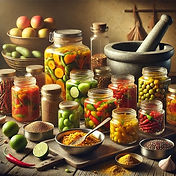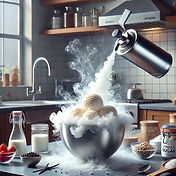Top Chef ™: World All-Stars
Season:
Week:
Elimination Challenge

The chefs were asked to create vegetable-forward dishes, where proteins served as the accompaniment. The dishes were served at the Temperate House in Kew Gardens. The guest judge was chef/director Angela Hartnett. Other diners in attendance included chef/owners Adam Handling and Brett Graham, chef patron Vineet Bhatia, and Kew Gardens botanical horticulturist Helena Dove.
Padma Lakshi: "For your first Top Chef ™ elimination challenge, we want you to create a vegetable forward dish where the protein is used more like a seasoning or an accent."
Tom Colicchio: "Vegetables are where all our flavor comes from, and more chefs are really focusing so much on produce."
Padma Lakshi: "This is an individual challenge. You'll each have £250 to shop at Whole Foods Market. Then tomorrow you'll have 2 hours to prep and cook at the Royal Botanic Gardens in Kew - a UNESCO World heritage site. You'll be serving a distinguished table of chefs from the United Kingdom. And your first guest judge of the season will be Michelin starred chef and Officer of the Order of the British Empire, Angela Hartnett."

As a family-run site, we pour our hearts into recording and transcribing cooking shows, developing tested recipes, and sharing culinary insights—all without bombarding you with ads.
Your low-cost subscription would help us cover ingredient costs and confirm that our passion project matters to you.
Please join our cooking community today.
Dishes prepared in
Top Chef ™: World All-Stars
Culinary Challenges inspired by
Top Chef ™: World All-Stars
Using beer as the primary liquid in pizza dough transforms your homemade crust into something extraordinary. The carbonation in beer creates additional air pockets throughout the dough, contributing to a lighter texture, while the alcohol promotes faster fermentation than water alone.
The malted barley in beer introduces natural sugars and enzymes that feed the yeast, accelerating fermentation and developing complex flavors. During baking, these sugars caramelize beautifully, creating that coveted golden-brown, crispy exterior.
The alcohol content also helps inhibit gluten formation, preventing the dough from becoming too chewy. Choose lighter beers for subtle flavor or craft ales for more pronounced notes. Remember to reduce salt slightly, as beer already contains sodium.
Tigelle are traditional Italian pocket breads from Emilia-Romagna, particularly the Modena mountains. These small, round flatbreads feature a distinct pattern from the special cast-iron molds they're cooked in.
The dough requires simple ingredients—flour, water, yeast and a touch of lard for authenticity—but needs proper resting time to develop flavor. Cook tigelle on medium heat in their traditional patterned presses or between two heavy skillets until golden with a slightly crisp exterior and tender interior.
Slice tigelle horizontally while warm and fill with classic combinations of cured meats, cheeses, and spreads like Parmigiano-Reggiano, prosciutto, or herb-infused lard (cunza).
These versatile breads shine as vehicles for both savory and sweet fillings.
Jollof rice is a beloved West African dish featuring rice cooked in a rich tomato-based sauce seasoned with aromatic spices. The key to perfect jollof is building layers of flavor. Start by sautéing onions until golden, then add tomatoes, peppers, and spices to create a deeply flavorful base.
The rice should cook slowly, absorbing the sauce until it develops its signature orange-red hue and each grain remains separate yet tender. Never rush jollof since it demands patience as it simmers to perfection. The slightly charred bottom layer (called "bottom pot" or "kanzo") is particularly prized.
Serve jollof rice hot, traditionally alongside fried plantains and your protein of choice.
Gastrique: Sweet-Sour Balance in French Cuisine
A gastrique is a sophisticated French sweet-and-sour sauce created by caramelizing sugar and deglazing with vinegar. This classic technique dates back to 17th century French haute cuisine, where it emerged as a way to balance rich dishes with bright acidity.
To prepare a basic gastrique, caramelize granulated sugar in a heavy saucepan until amber-colored, then carefully deglaze with vinegar (wine, fruit, or balsamic). Once incorporated, add stock or fruit purees for additional flavor complexity, and simmer until slightly thickened.
Modern gastriques often feature fruit elements like orange, raspberry, or fig paired with complementary vinegars. The resulting sauce - tangy, sweet, and slightly syrupy - adds brilliant contrast to rich proteins like duck breast, pork tenderloin, or seared scallops, cutting through richness while enhancing the dish's depth. Equally, a gastrique can be used on a dessert to add piquancy.
In Season 22 of Top Chef ™ we saw Cesar making a dessert from pickles, and part of his dish was a gastrique made from Bread and Butter Pickles.
Jus lié is a classic French culinary technique that refers to a meat sauce or gravy that has been lightly thickened. The term translates directly to "bound juice" in English.
It's made by taking a natural meat stock or pan drippings (jus) and thickening it slightly with a starch, typically a roux (butter and flour mixture), cornstarch, or arrowroot. Unlike a full gravy, jus lié maintains much of the clarity and intense flavor of the original jus while having just enough body to coat the back of a spoon.
In traditional French cuisine, jus lié often serves as an elegant finishing sauce for roasted meats, providing richness and moisture without overwhelming the main protein. The subtle thickening enhances the sauce's ability to cling to meat while maintaining the pure, concentrated flavors of the meat juices.
Chefs appreciate jus lié for striking the perfect balance between the intensity of a pure jus and the coating properties of a thicker sauce.
Cannolo (singular of cannoli) is an iconic Sicilian pastry featuring a crispy tubular shell traditionally filled with sweetened ricotta cream. Dating back to Arab-ruled Sicily (9th-11th centuries), legend claims they were created in a harem near Caltanissetta as a fertility symbol for Carnival celebrations.
To make authentic cannoli, create a dough with flour, sugar, butter, egg, and marsala wine. Roll thin, wrap around metal tubes, then fry until golden and crisp. The classic filling combines sheep's milk ricotta with sugar, candied fruits, and sometimes chocolate chips or pistachios.
The secret to perfect cannoli lies in filling the shells just before serving to maintain their delightful contrast between crispy exterior and creamy interior. Traditionally dusted with powdered sugar and garnished with candied orange peel or chopped pistachios.
Cannolo, while traditionally a Sicilian sweet pastry, offers exciting possibilities for savory reinvention. The iconic crispy tubular shell can be brilliantly transformed into an elegant savory appetizer or main course component.
To create savory cannoli, prepare the shell dough without sugar, incorporating herbs or spices instead. After frying to golden perfection, fill with savory mixtures like herb-infused goat cheese, seasoned ricotta with sun-dried tomatoes, smoked salmon with cream cheese, or even spiced meat fillings.
The tubular shape is designed for handheld eating. This practical form maintains the essential textural contrast—crispy exterior with creamy interior—that makes cannoli so satisfying in both sweet and savory applications. Keep the shells separate from filling until serving for maximum crispness.
Obe Ata is a vibrant red pepper sauce central to Nigerian cuisine, particularly Yoruba cooking. This aromatic base combines red bell peppers, scotch bonnet or habanero peppers, tomatoes, onions, and sometimes garlic, all blended and then slowly simmered until rich and flavorful.
To prepare authentic Obe Ata, blend the peppers, tomatoes, and onions until smooth. Heat palm oil (or vegetable oil) in a pot, then simmer the blended mixture on low heat, allowing the water to evaporate and the flavors to concentrate. Season with salt, bouillon, and traditional spices like locust bean (iru) for depth.
Obe Ata serves as the foundation for numerous Nigerian stews and is traditionally paired with rice, yam, or enjoyed with protein like fish or beef.
Tsukune are Japanese chicken meatballs, popular in yakitori restaurants and izakayas.
These juicy meatballs combine ground chicken with finely chopped onions, ginger, and sometimes shiitake mushrooms. The mixture is typically seasoned with soy sauce, sake, and mirin, then shaped around skewers before grilling.
What makes tsukune distinctive is their texture—slightly bouncy yet tender—achieved by kneading the mixture until sticky. They're typically glazed with tare (a sweet-savory sauce) during grilling for a caramelized finish.
Home cooks can bake them instead of grilling and adjust the seasonings to taste. For authentic texture, include cartilage or use chicken thigh meat with its natural fat. Serve tsukune hot, brushed with additional tare and optionally topped with a sprinkle of sansho pepper.
Togarashi (Japanese for "chili pepper") commonly refers to shichimi togarashi, a seven-spice blend featuring chili peppers, orange peel, sesame seeds, nori, ginger, sansho pepper, and hemp seeds. This versatile condiment adds heat, umami, and complexity to noodles, rice, grilled meats, and vegetables.
Store togarashi in an airtight container away from light and heat. For freshest flavor, purchase small amounts or make your own by toasting and mixing the ingredients to your preferred balance of heat and flavor.
A "fennel pollen togarashi" variation could substitute fennel pollen for traditional nori, creating a unique blend with delicate anise notes that pairs exceptionally well with seafood, especially grilled fish. This fusion version would bring Mediterranean floral sweetness to the traditional Japanese spice profile.
Achar is a popular South Asian condiment, consisting of pickled fruits or vegetables preserved in oil, vinegar, and spices. This tangy, spicy relish adds bold flavor to meals across India, Pakistan, Nepal, and Bangladesh. Common varieties include mango (aam), lime (nimbu), and mixed vegetable achar.
The pickling process traditionally involves sun-drying ingredients before mixing with mustard oil and spice blends that typically include fenugreek, fennel, mustard seeds, and asafoetida. Achar serves as an essential accompaniment to everyday meals, providing contrasting flavors that enhance rice, bread, curries, and other dishes.
Making Ice Cream with Liquid Nitrogen
Liquid nitrogen ice cream offers home cooks a spectacular culinary adventure, creating the smoothest, creamiest frozen dessert possible. At -320°F, liquid nitrogen flash-freezes ice cream base instantly, preventing large ice crystals from forming—the secret to its extraordinarily silky texture.
The process is surprisingly straightforward: prepare your favorite ice cream base (typically cream, milk, sugar, and flavorings), then slowly pour liquid nitrogen into the mixture while continuously stirring. The dramatic plume of fog that billows out creates an impressive kitchen spectacle as your cream transforms into ice cream within minutes.
Safety precautions are absolutely essential. Always use insulated gloves, protective eyewear, and work in a well-ventilated area. Use metal or wooden mixing bowls—never glass, which could shatter. Always keep the liquid nitrogen container in an upright position and never seal it in a closed container.
While not an everyday technique, liquid nitrogen ice cream makes for a memorable cooking demonstration or special occasion dessert. The rapid freezing preserves flavors exceptionally well, allowing delicate notes to shine through that might otherwise be lost in traditional churning methods. For the culinary adventurer, it's a fascinating intersection of food science and dessert artistry that creates an unforgettable dining experience.
Ceviche Jipijapa is a distinctive Ecuadorian seafood dish hailing from the coastal town of Jipijapa in Manabí province. This regional specialty transforms fresh fish (typically corvina or sea bass) by "cooking" it in citrus juice—traditionally a mixture of bitter orange and lime. What sets Jipijapa ceviche apart is its characteristic creamy texture achieved through the addition of peanut butter or ground peanuts.
The dish combines the citrus-marinated fish with finely diced tomatoes, red onions, cilantro, and the crucial peanut element, creating a harmonious balance of bright acidity, oceanic freshness, and nutty richness. Often served with chifles (plantain chips), toasted corn, or popcorn for textural contrast,
Ceviche Jipijapa represents the indigenious coastal cuisine of Ecuador that celebrates local ingredients and flavors.




































